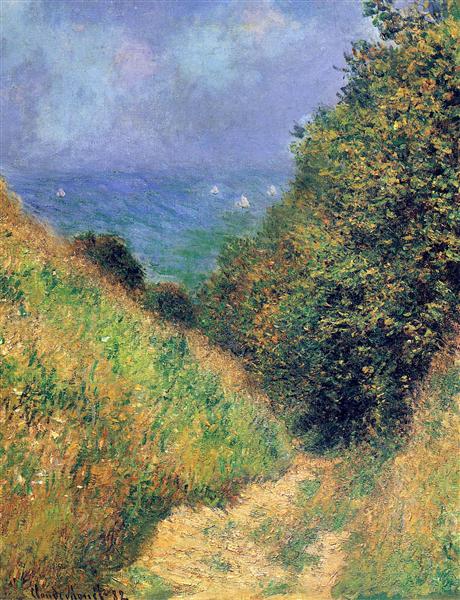תיאור
Claude Monet's "Path at Pourville 02" painted in 1882 invites us to reflect deeply on the interaction between light, colour and nature, intrinsic characteristics of the Impressionist movement of which Monet is one of the greatest exponents. This painting not only captures a moment in time, but also offers a moving representation of the landscape of Pourville-sur-Mer, a small town on the Normandy coast that Monet frequented and which inspired numerous works.
Looking at the composition, we find a winding path leading us through a vibrant and dynamic campsite. The path appears to be gilded by sunlight, which bathes the scene through a clearing, creating a play of light and shadow that evokes the sense of movement and constant transformation in nature. Monet’s loose and energetic brushstrokes are evident, conveying the impression of immediacy and spontaneity, qualities that become essential in Impressionism. This technique of applying color, using short, quick strokes, allows the viewer to feel the breeze and the fresh atmosphere of the place, immersing them in the visual experience.
Color is a crucial element in this work. Monet uses a palette that fluctuates between yellow, green, and blue hues, evoking a luminous and almost ethereal atmosphere. The soft greens of the grass contrast with the deep blue of the sky, while the golden reflections of the path suggest the warmth of the sun and summer. This careful choice of colors not only describes nature, but also does so in a way that resonates emotionally with the viewer, evoking a sense of peace and tranquility.
Unlike Monet's other works, this painting does not feature human figures to distract the viewer's attention. Instead, the focus falls on the natural space, giving it an almost mystical presence. This also reflects Monet's concern with the ephemeral and the changing, a recurring theme in his work, where lighting conditions are fundamental to the interpretation of the scene.
When placing this work in the context of Monet's production, it is important to highlight his artistic evolution. By the early 1880s, Monet had moved away from more formal and academic compositions, seeking instead to capture the immediacy of the visual experience. "Road at Pourville 02" aligns with other works from this period, where the focus is on the pure perception of light and atmosphere. These works also reveal his interest in the representation of landscape as a reflection of the artist's emotional state.
It is interesting to note that Monet, like other impressionists, sought to challenge the artistic conventions of his time. He painted outdoors or "en plein air", approaching nature with an approach that prioritized atmosphere over form. Through "Road in Pourville 02", we can observe the progressive liberation from traditional forms of representation and a freer and more expressive approach to painting.
Ultimately, “Road at Pourville 02” becomes a celebration of nature and light, in which Monet succeeds not only in depicting a landscape, but also in conveying a lived experience. The work is a testament to Monet’s exceptional talent as a master of light and color, and as a pioneer of a new aesthetic language that would go on to influence successive generations of artists. Through his work, the viewer is invited to contemplate not only the beauty of the natural world, but also the transience of each instant – a notion deeply resonant in the philosophy of Impressionism.
KUADROS ©, a famous painting on your wall.
Hand-made oil painting reproductions, with the quality of professional artists and the distinctive seal of KUADROS ©.
Painting reproduction service with satisfaction guarantee. If you are not completely satisfied with the replica of your painting, we will refund 100% of your money.

